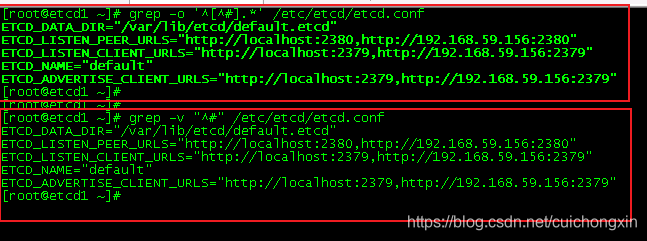linux过滤空格、linux过滤注释行(^#)、linux过滤空白行(^&)
文章目录说明去除空格说明去除行首空格去除行尾空格去除所有空格去除空白行方法1(最简单)方法2(简单)方法3方法4去除注释行同时去除注释行和空白行说明本文主要说明 如何去除 文档中的 注释行、空白行以及过滤空格。去除空格说明去除空格会涉及到 正则关系,我先在这对一些符号做下说明,下面有看不懂的地方回来看这的解析!!!如:sed 's/^[ ]*//g'表示使用空字符匹配行首为空格的字符串;依次拆解释
·
说明
本文主要说明 如何去除 文档中的 注释行、空白行以及过滤空格。
去除空格说明
- 去除空格会涉及到 正则关系,我先在这对一些符号做下说明,下面有看不懂的地方回来看这的解析!!!
- 如:
sed 's/^[ ]*//g'表示使用空字符匹配行首为空格的字符串; - 依次拆解释义:
- 字符
's'表示替换; - 字符
'/'表示作为分隔符; - 字符
'^'表示开头; - 字符
'$'表示结尾; - 字符
'*'表示所有; - 字符
'[ ]'表示匹配指定字符范围内的任意单个字符,[ ]中含一个空格; - 字符
'g’表示全部匹配;
- 字符
- 去除空格的使用场景可以分为:去除行首空格、去除行尾空格以及去除所有空格,我下面单独说明
去除行首空格
- 命令:
sed 's/^[ ]*//g' - 用脚本展示使用方法和效果吧:
[root@centos76_1 ccx]# sh space.sh
def ——未去除空格
def ——已去除行首空格
[root@centos76_1 ccx]#
[root@centos76_1 ccx]#
[root@centos76_1 ccx]# cat space.sh
#!/bin/bash
str=' def '
echo "$str——未去除空格"
echo "$str——已去除行首空格" | sed 's/^[ ]*//g'
[root@centos76_1 ccx]#
去除行尾空格
- 命令:
sed 's/[ ]*$//g' - 用脚本展示使用方法和效果吧:
注:这个比较特殊,用字符串数量的形式来证明已经去除了(当时搞了好久,以为出问题了。。。)
[root@centos76_1 ccx]# sh space.sh
未去空格前字符串数量:12
去除空格后字符串数量:7
ccx 后面加东西后依然存在
[root@centos76_1 ccx]#
[root@centos76_1 ccx]# cat space.sh
#!/bin/bash
#str=' defc '
#echo "$str" | sed 's/[ ]*$//g'
var=' ccx '
var1=$(echo "${var}")
echo "未去空格前字符串数量:${#var1}"
var2=$(echo "${var}" |sed 's/[ ]*$//g')
echo "去除空格后字符串数量:${#var2}"
echo "$var""后面加东西后依然存在" | sed 's/[ ]*$//g'
[root@centos76_1 ccx]#
去除所有空格
- 命令:
sed 's/[[:space:]]//g' - 用脚本展示使用方法和效果吧:
[root@centos76_1 ccx]#
[root@centos76_1 ccx]# sh space.sh
defc ——start
defc——end
[root@centos76_1 ccx]#
[root@centos76_1 ccx]# cat space.sh
#!/bin/bash
str=' defc '
echo "$str"——start
echo "$str"——end | sed 's/[[:space:]]//g'
[root@centos76_1 ccx]#
去除空白行
方法1(最简单)
- 命令:
grep -v "^$" - 前面任何查看的方式都行,这命令放管道符后面即可,效果如下
[root@centos76_1 ccx]# cat test.txt | grep -v "^$"
#dfda sf
dfadf
oodfadsf
fdf df ddf
daf da
fff
ddd
ddd ddf
# ddd
#aaa cc
[root@centos76_1 ccx]# cat test.txt
#dfda sf
dfadf
oodfadsf
fdf df ddf
daf da
fff
ddd
ddd ddf
# ddd
#aaa cc
[root@centos76_1 ccx]#
方法2(简单)
- 命令:
tr -s '\n' - 前面任何查看的方式都行,这命令放管道符后面即可,效果如下
[root@centos76_1 ccx]# cat test.txt | tr -s '\n'
#dfda sf
dfadf
oodfadsf
fdf df ddf
daf da
fff
ddd
ddd ddf
# ddd
#aaa cc
[root@centos76_1 ccx]# cat test.txt
#dfda sf
dfadf
oodfadsf
fdf df ddf
daf da
fff
ddd
ddd ddf
# ddd
#aaa cc
[root@centos76_1 ccx]#
方法3
- 命令:
sed '/^$/d' - 前面任何查看的方式都行,这命令放管道符后面即可,效果如下
[root@centos76_1 ccx]# cat test.txt | sed '/^$/d'
#dfda sf
dfadf
oodfadsf
fdf df ddf
daf da
fff
ddd
ddd ddf
# ddd
#aaa cc
[root@centos76_1 ccx]# cat test.txt
#dfda sf
dfadf
oodfadsf
fdf df ddf
daf da
fff
ddd
ddd ddf
# ddd
#aaa cc
[root@centos76_1 ccx]#
方法4
- 命令:
awk '{if($0!="")print}' - 前面任何查看的方式都行,这命令放管道符后面即可,效果如下
[root@centos76_1 ccx]# cat test.txt | awk '{if($0!="")print}'
#dfda sf
dfadf
oodfadsf
fdf df ddf
daf da
fff
ddd
ddd ddf
# ddd
#aaa cc
[root@centos76_1 ccx]# cat test.txt
#dfda sf
dfadf
oodfadsf
fdf df ddf
daf da
fff
ddd
ddd ddf
# ddd
#aaa cc
[root@centos76_1 ccx]#
去除注释行
方式一【简单】
- 命令:
grep -v "^#" file - 前面任何查看的方式都行,这命令放管道符后面即可,效果如下
下面命令我只是换了一种方法而已,与cat test.txt | grep -v "^#"同效果
[root@centos76_1 ccx]# grep -v "^#" test.txt
dfadf
oodfadsf#
fdf df# ddf
daf da
fff
ddd
ddd ddf
[root@centos76_1 ccx]# cat test.txt
#dfda sf
dfadf
oodfadsf#
fdf df# ddf
daf da
fff
ddd
ddd ddf
# ddd
#aaa cc
[root@centos76_1 ccx]#
方式二【复杂】
- 命令:
grep -o '^[^#].*' file - 这种效果和上面一样的,只是这种是选中,上面种是过滤罢了,选中代码高亮,看得懂吧。

代码展示这2者效果
[root@etcd1 ~]# grep -o '^[^#].*' /etc/etcd/etcd.conf
ETCD_DATA_DIR="/var/lib/etcd/default.etcd"
ETCD_LISTEN_PEER_URLS="http://localhost:2380,http://192.168.59.156:2380"
ETCD_LISTEN_CLIENT_URLS="http://localhost:2379,http://192.168.59.156:2379"
ETCD_NAME="default"
ETCD_ADVERTISE_CLIENT_URLS="http://localhost:2379,http://192.168.59.156:2379"
[root@etcd1 ~]#
[root@etcd1 ~]# grep -v "^#" /etc/etcd/etcd.conf
ETCD_DATA_DIR="/var/lib/etcd/default.etcd"
ETCD_LISTEN_PEER_URLS="http://localhost:2380,http://192.168.59.156:2380"
ETCD_LISTEN_CLIENT_URLS="http://localhost:2379,http://192.168.59.156:2379"
ETCD_NAME="default"
ETCD_ADVERTISE_CLIENT_URLS="http://localhost:2379,http://192.168.59.156:2379"
[root@etcd1 ~]#
同时去除注释行和空白行
- 其实就是把前面提到的2个命令放一条执行而已;
- 命令:
grep -v "^#" | grep -v "^$" - 前面任何查看的方式都行,这命令放管道符后面即可,效果如下
[root@centos76_1 ccx]# cat test.txt | grep -v "^#" | grep -v "^$"
dfadf
oodfadsf#
fdf df# ddf
daf da
fff
ddd
ddd ddf
[root@centos76_1 ccx]#
[root@centos76_1 ccx]# cat test.txt
#dfda sf
dfadf
oodfadsf#
fdf df# ddf
daf da
fff
ddd
ddd ddf
# ddd
#aaa cc
[root@centos76_1 ccx]#
更多推荐
 已为社区贡献16条内容
已为社区贡献16条内容









所有评论(0)